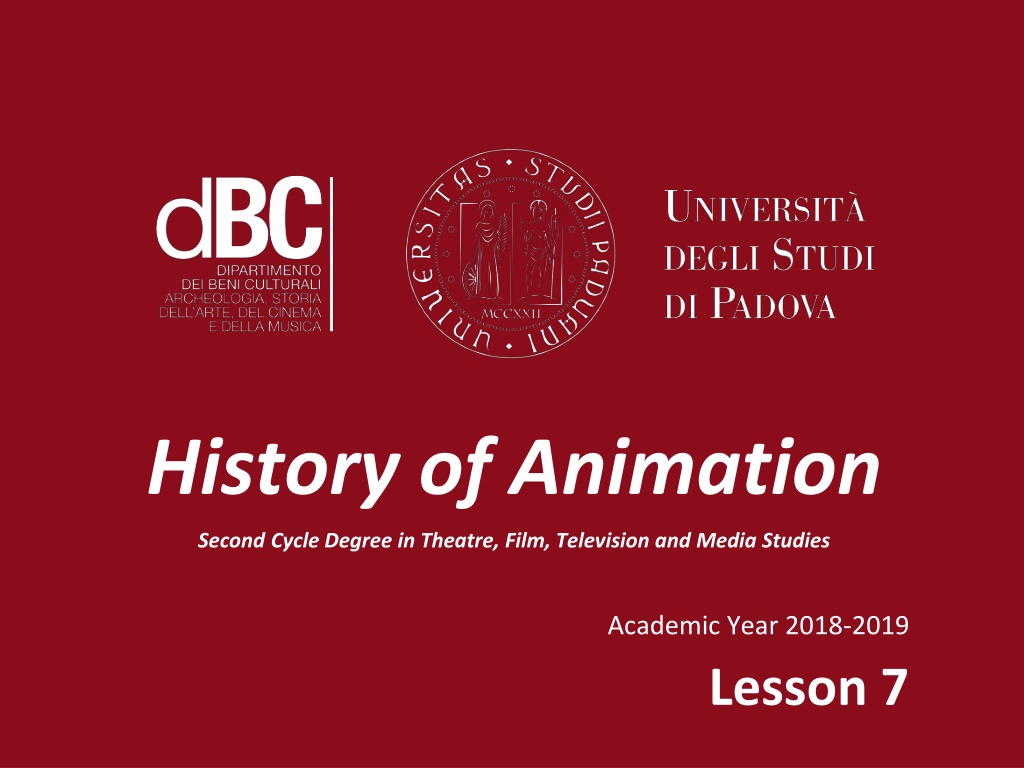
Origins of Animated Cinema in Early 20th Century
Explore the fascinating origins of animated cinema in the early 20th century, debunking the myth that animation was unknown until 1907. Discover the success of films like "The Haunted Hotel" and the works of pioneers like Georges Méliès and Segundo de Chomón, shedding light on the evolution of animation as an art form.
Download Presentation

Please find below an Image/Link to download the presentation.
The content on the website is provided AS IS for your information and personal use only. It may not be sold, licensed, or shared on other websites without obtaining consent from the author. If you encounter any issues during the download, it is possible that the publisher has removed the file from their server.
You are allowed to download the files provided on this website for personal or commercial use, subject to the condition that they are used lawfully. All files are the property of their respective owners.
The content on the website is provided AS IS for your information and personal use only. It may not be sold, licensed, or shared on other websites without obtaining consent from the author.
E N D
Presentation Transcript
History of Animation Second Cycle Degree in Theatre, Film, Television and Media Studies Academic Year 2018-2019 Lesson 7
The Beginning of Animated Cinema Animation has bred a myth about its own origins that goes, according to the film historian s lore, like this: Animation was virtually unknown until 1907. It was then that L H tel hant opened in Paris. The public response to this first animated film was so strong that all the French producers racked their brains trying to figure out the tricks that made objects move by themselves. After considerable difficulty, the secret was discovered and the history of cartoons could begin . Donal Crafton, Before Mickey. The Animated Film 1898-1928, The University of Chicago Press, Chicago, 1993, p. 13.
The Beginning of Animated Cinema The Haunted Hotel; or, The Strange Adventures of a Traveler (Vitagraph of America, James Stuart Blackton, 1907)
The Beginning of Animated Cinema Why was The Haunted Hotel a success? The theme was not new. It was quite a common plot for stage acts and early films. Donald Crafton lists at least seven films with a similar story among 1896 and 1900. Some of them were by Georges M li s, pioneer and master of trick films.
The Beginning of Animated Cinema L Auberge ensorcel e (Georges M li s, 1897)
The Beginning of Animated Cinema L Auberge du bon repos (Georges M li s, 1903)
The Beginning of Animated Cinema After Blackton s film, the theme was even revived. Its most relevant iteration was created by Spaniard Segundo de Chom n (1871-1929). Later a director and a professional of special effects for Path trickfilms and for Itala Film in Turin (since 1912: he authored the special effects of Giovanni Pastrone sCabiria, 1914), Chom n tried to improve Blackton s idea with El hotel el ctrico (1908).
The Beginning of Animated Cinema El hotel el ctrico (Segundo de Chom n, 1908)
The Beginning of Animated Cinema James Stuart Blackton The Haunted Hotel was not even Blackton s first animation. Born in Sheffield (UK) in 1875, Blackton moved to the USA at the age of ten. He interviewed Thomas Alva Edison as a teenage journalist; as he confessed to an aptitude for drawing, he was asked to draw Edison s portrait while a camera filmed the scene. The episode started Blackton s career in cinema. Blackton had direct experience with chalktalks or lightning sketches , a quite common kind of vaudeville act. He translated it into film, maybe realizing that drawings could be animated by single-framing techniques, just like objects.
The Beginning of Animated Cinema James Stuart Blackton The enchanted drawing (James Stuart Blackton, 1900)
The Beginning of Animated Cinema James Stuart Blackton Humorous Phases of Funny Faces (James Stuart Blackton, 1906)
The Beginning of Animated Cinema James Stuart Blackton Lighting Sketch (James Stuart Blackton, 1907)
The Beginning of Animated Cinema James Stuart Blackton The Haunted Hotel was such a sensational film partly because of some clever and hyperbolic advertising, but more importantly because some of its scenes displayed stand-alone object animation. Sometimes, animation stopped being a mere trick and became an independent expressive device: it was no more just a funny disturbance to live-action, but something of equal importance. The Vitagraph film The Haunted Hotel was a sensation and rightly so. Abandoning all the tricks of the movies, they had contrived entirely new and totally unexpected combinations of techniques. As we watched, the sharpest, most attentive eye was unable to detect any wires. One had to be informed of the process . Victorin Jasset, 1911, quoted in Crafton, op. cit., p. 16.
The Beginning of Animated Cinema As argued by Giannalberto Bendazzi (who follows C. W. Ceram [Kurt Wilhelm Marek]), a history of cinema animation should start when the animation process is no more a mere series of techniques, but it becomes a foundation for creativity and it gives rise to a new productive stage. The first requirement was surely met by The Haunted Hotel, and even earlier films complied with it (Matches: An Appeal, by Arthur Melbourne Cooper, 1899).
The Beginning of Animated Cinema Matches: An Appeal (Arthur Melbourne Cooper, 1899)
The Beginning of Animated Cinema As to find evidence of the second requirement (rise of a new productive stage), however, it is necessary to wait until 1908: the year when, according to legend, a filmmaker finally discovered the trick behind Blackton sThe Haunted Hotel. That man was the eclectic artist mile Courtet, also known as mile Cohl (1857-1938), who in 1907, at 50, joined Gaumont to begin his career in cinema.
The Beginning of Animated Cinema mile Cohl
The Beginning of Animated Cinema mile Cohl mile Cohl - - Born in 1857 from a rubber salesman and a linen seamstress. 1867: Cohl discovers the works of Andr Gill, the best-known caricaturist of the day. 1878: he changes his surname from Courtet to Cohl and becomes assistant to Andr Gill. He learns a style of caricature whose trademark was a large head atop a small puppet-like body. 1879: editor of L Hydropathe, satiric journal of the artistic circle Les Hydropathes, created in 1878 by mile Goudeau. 1882: the Hydropathes are disbanded, Cohl joins the Incoherents, founded by Jules L vy. 1883: editor in chief at La Nouvelle Lune. 1885: death of Andr Gill. 1888: end of the Incoherents. - - - - - -
The Beginning of Animated Cinema mile Cohl Les hommes d aujourd hui, no. 460, 1897
The Beginning of Animated Cinema mile Cohl Cohl was like a chameleon of many colours. He worked as a caricaturist for several magazines, such as Les hommes d aujourd hui, to which he supplied caricatures of Verlaine and Toulouse-Lautrec. (In 1894, that same magazine confirmed Cohl s vast notoriety by dedicating to him a cover caricature signed by Uz s). In the 1880s, Cohl turned successfully to photography. His light comedies were performed in the theatres of the boulevards and, last but not least of his numerous hobbies, he was interested in puzzles and magic tricks . Giannalberto Bendazzi, Cartoons. One Hundred Years of Cinema Animation, John Libbey, London, 194, p. 9.
The Beginning of Animated Cinema mile Cohl During the winter [of 1908], Cohl had been walking in Monmartre when he noticed a poster for a film that apparently stole an idea from one of his comic strips. That this was a common practice at the time did little to assuage his temper, and he stalked over to the Gaumont studios to demand compensation. There he was met by Louis Feuillade, the artisticdirector of the company and the future director of Fantomas. Feuillade, no doubt secretly amused by the old man s wrath, offered him a job writing scenarios. [ ] Cohl took the offer seriously and wrote several f eries. [ ] While he was writing scenarios, Cohl was also working on the Fantasmagorie drawings. The cartoon was completed in July and released in August, and was an international success. Cohl s subsequent work pleased L on Gaumont, and in January 1909 [ ] he was made a full-time salaried director. By the time he left the studio in 1910, Cohl would complete 77 films . Donald Crafton, Before Mickey. The Animated Film 1898-1928, The Chicago University Press, Chicago, 1993, pp. 65-66.
The Beginning of Animated Cinema mile Cohl Fantasmagorie ( mile Cohl, 1908)
The Beginning of Animated Cinema mile Cohl Does Fantasmagorie reference any genre of early cinema? Is it just a f erie? At the beginning it foregrounds the author, just like in Blackton s lighting sketches. But then, the author disappears . The attraction is no more the display of a magician s trick . Animation is no more a matter of making things appear or disappear, or of moving objects around. The motion itself, instead, takes center stage, by causing seamless metamorphoses. The lines are simple, the characters are abstract and naive; but that does not matter, as Cohl is more interested in motion than in what is moving. Moreover: with Cohl, animation starts to define its own visual grammar.
The Beginning of Animated Cinema mile Cohl Clair de lune espagnol ( mile Cohl, 1909)
The Beginning of Animated Cinema mile Cohl Le retapeur de cervelles ( mile Cohl, 1910)
The Beginning of Animated Cinema mile Cohl Le cheveu d lateur ( mile Cohl, 1911)
The Beginning of Animated Cinema mile Cohl In 1910, after an unsuccessful request for a raise, Cohl left Gaumont for Path . But he was pressured to do live-action and trick films. Only one of his eigth Path films survives Le Retapeur de cervelles. Through his friend and technical mentor tienne Arnaud, Cohl was able to find a new job at the Eclair Company Studio in Fort Lee, New Jersey, USA. From 1912 to 1914 Cohl worked on the series TheNewlyweds , based on a newspaper comic strip by George McManus. It was in an advertisement for TheNewlyweds that the phrase animated cartoons was first used to describe this new genre. A fire destroyed all of Cohl s American works in 1914. A fire, indirectly, marked also the end of Cohl s existence: in 1937, poor and forgotten, he knocked over an oil lamp. He died of pneumonia in a charity hospital, on January 20, 1938.
The Beginning of Animated Cinema mile Cohl Cohl created animation also because with his work, for the first time, he defined what is an animator. He became the first of many similar individuals who would eventually populate animation studios everywhere. Among the distinctive features of this personality profile are a background in journalism, a compulsion to sketch, workaholic tendencies, and a well-developed but idiosyncratic sense of humor. Cohl was the first to bring to the cinema the necessary qualities of intellect, imagination, patience, and the obsessive love of drawing that would mark other great animators . Crafton, op. cit., p. 60.
The Beginning of Animated Cinema mile Cohl
Suggested readings Donald Crafton, The Secret of the Haunted Hotel , in Before Mickey. The Animated Film 1898-1928, The University of Chicago Press, Chicago, 1993, pp. 13-33. Id., The First Animator: Emile Cohl ,ivi, pp. 58-88. Giannalberto Bendazzi, Animation. A World History. 3 voll., Waltham, Massachusetts: Focal Press, 2015. Vol. I, pp. 35-43: The Silent Pioneers (1908-1928) (to study from and including- the section WinsorMcCay ).






















